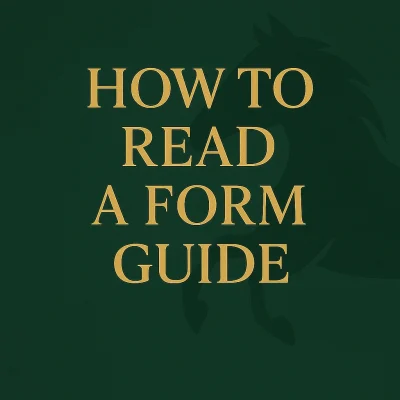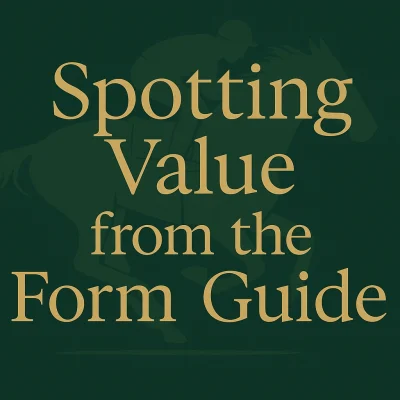When it comes to learning about horse racing betting, the form guide is your best friend, and possibly your biggest edge. While a racecard simply tells you who’s running, the form guide tells you how well they’ve been running. It’s the difference between picking a name and making an informed, strategic bet.
A form guide provides a snapshot of a horse’s recent performances, revealing crucial details like finishing positions, ground preferences, class levels, and even the jockey’s influence. Learning how to interpret this data lets you spot patterns, assess consistency, and uncover hidden value. It’s this kind of insight that separates casual punters from serious bettors.
Whether you’re scanning a Racing Post form line, checking stats at horse racing betting sites, or studying trends before placing your next bet, understanding how to read form is essential. In this guide, we’ll break down what the figures mean, how to interpret the symbols, and how to use form to find winners.
What is a Horse Racing Form Guide?
 A form guide is a detailed record of a horse’s past performances, designed to help punters judge how likely it is to perform well in upcoming races. Think of it as a horse’s CV, a running history that lists where, when, and how it’s raced, plus the conditions it faced along the way.
A form guide is a detailed record of a horse’s past performances, designed to help punters judge how likely it is to perform well in upcoming races. Think of it as a horse’s CV, a running history that lists where, when, and how it’s raced, plus the conditions it faced along the way.
You’ll find form guides on most leading betting sites, as well as trusted racing resources like Racing Post, Sporting Life, and At The Races. While each source presents data slightly differently, they all serve the same purpose, to give you the insight you need before placing a bet.
By analysing a form guide, you can spot patterns of consistency, identify horses that thrive under certain conditions, and notice when a runner might be ready to strike after a string of near misses. A good gambler uses the form not just to see results, but to interpret the story behind them. They can learn who was improving, who had excuses, and who looks primed for a big run today.
Breaking Down the Form Figures
At first glance, a line of form figures like 1-23F or P6-1 might look like a jumble of numbers and letters. But once you know what each symbol means, you’ll start to see the story behind every horse’s recent runs.
Each figure or letter in the form guide represents the horse’s finishing position or race outcome, with the most recent run always shown on the right. Here’s a quick breakdown of the most common symbols:
| Symbol | Meaning | Example |
|---|---|---|
| 1 | 1st place (winner) | 1-23F = horse won four runs ago |
| 2 | 2nd place (runner-up) | consistent performer |
| 3, 4, 5 | Finished 3rd, 4th, or 5th | solid but not quite winning form |
| 0 | Finished outside the top 9 or unplaced | less competitive |
| P / PU | Pulled up (did not finish) | often in jumps racing |
| F | Fell | common in steeplechase or hurdle races |
| U / UR | Unseated rider | jockey came off mid-race |
| R / RO | Refused or ran out | horse refused a jump or veered off course |
For example:
- 1-23F means the horse won, then finished 2nd, 3rd, and fell last time out.
- P6-1 means the horse was pulled up, then finished 6th, and won its most recent race.
When reading form, focus on the order (right to left) and look for consistency or signs of improvement. A horse showing steady finishes like 3-2-1 is clearly heading in the right direction, while a string of 0s may signal it’s struggling for form — unless it’s dropping in class or returning to its preferred conditions.
Understanding Key Form Symbols
Once you’ve got the hang of reading the basic form figures, the next step is learning the symbols and abbreviations that provide extra insight. These little codes reveal valuable clues about where, how, and under what conditions a horse has performed. It’s these details that often separate a good bet from a great one.
| Symbol | Meaning | Why It Matters |
|---|---|---|
| C | Course winner – has won at this track | Proven ability on the same track can be a big advantage, especially at tricky courses like Cheltenham or Epsom. |
| D | Distance winner – has won over today’s trip | Indicates suitability for the trip, crucial when comparing sprinters to stayers. |
| CD | Course & Distance winner | One of the strongest indicators of repeat potential. |
| BF | Beaten favourite | Often means punters expected better; may be capable of bouncing back next time. |
| OR | Official Rating – the BHA’s rating | Used to set weights in handicaps; lower OR = more lenient weight. |
| RPR | Racing Post Rating | Helpful for comparing performances across different races and conditions. |
| TS | Top Speed | Useful for identifying genuinely fast runners on specific going types. |
| UR / PU / RO / F | Unseated / Pulled Up / Ran Out / Fell | Indicates non-completion — more relevant for jumps racing. |
When you see combinations like CD BF or D OR132, you’re reading layers of performance data, not just how a horse finished, but under what circumstances. A CD winner carrying a competitive Official Rating and trained by an in-form yard can be a major positive sign when assessing the field.
Racing Form Beyond the Numbers
Once you’ve mastered the basic figures and abbreviations, it’s time to dig deeper. True betting insight comes from understanding the context behind those numbers. What type of race it was, how much weight the horse carried, the conditions on the day, and whether the trainer or jockey were in good form.
These factors can completely change the meaning of a horse’s past results and help you predict how they might perform today.
1. Class of Race
Every race is run at a specific class level, ranging from Class 1 (top level) down to Class 7 (lowest) on the Flat, and similar tiers for National Hunt races. A horse that’s been performing well in lower-class races might struggle when moving up, while one dropping in class after tough competition could suddenly look much more competitive.
Always check whether the horse is racing at the same level, stepping up, or dropping down, as it’s one of the strongest indicators of how it might fare.
2. Weight Carried
In handicap races, horses carry different weights based on their Official Rating (OR). A higher-rated horse carries more weight to even out the competition. A small change of even a few pounds can make a difference, especially in soft ground or over long distances.
If a horse won easily last time but now carries a heavier weight, that may balance things out. Conversely, a runner that’s dropped a few pounds since its last start might be poised to strike.
3. Distance & Going Preferences
Some horses are specialists over certain distances. a sprinter might excel over 5f or 6f, while a stayer needs 1m6f or more. Similarly, going (ground conditions) plays a massive role: “firm”, “good”, “soft”, or “heavy” can make or break a horse’s chances.
Look for patterns in the form guide that show when the horse ran best. For example, a string of strong runs on good to soft going might hint that firmer ground won’t suit.
4. Jockey & Trainer Form
Even the best horse can underperform if the trainer or jockey is out of form. A quick check on whether the trainer’s recent runners are winning (often shown as a % strike rate) can tell you a lot. Some trainers also target specific meetings or tracks, so seeing a familiar name in the right race can be a valuable clue.
Likewise, a top jockey booking, especially if they’ve ridden the horse to success before, is a sign of intent that punters shouldn’t overlook.
Spotting Value from the Form Guide
 The real art of reading form isn’t just knowing what the numbers mean, it’s knowing how to use them to spot value. Any punter can pick a favourite; the smart ones find horses that are underrated by the market and overdue a big run.
The real art of reading form isn’t just knowing what the numbers mean, it’s knowing how to use them to spot value. Any punter can pick a favourite; the smart ones find horses that are underrated by the market and overdue a big run.
Form analysis helps you do exactly that by revealing the context behind each performance. Here’s how to turn those figures into genuine betting insight:
1. Look for Improvement Patterns
Horses often progress over a series of runs, especially younger types or those returning from a break. A sequence like 5-3-2 might not look exciting at first, but it shows steady progress. If today’s conditions mirror the last run, that horse could be ready to win. Equally, a horse returning to a winning distance or class can be a major clue that it’s been laid out for today’s race.
2. Spot the “Unlucky” Runs
Not every poor result tells the full story. Horses can be blocked for a run, bumped, or simply find the race run at an unsuitable pace. When the form guide shows a poor finish but the race comments mention “denied clear run” or “stayed on strongly”, it’s often worth a second look. These can be value horses overlooked by casual punters.
3. Identify Unsuitable Conditions Last Time Out
A horse that ran poorly on heavy ground might bounce back on good going, or one that struggled over 1m4f could excel when dropped back to 1m2f. By spotting when conditions were against a horse last time, you can get ahead of the market before others realise it’s back in its comfort zone.
4. Recognise “Plot Horses” in Handicaps
Some trainers like to “plot” a horse, running it in less suitable races to get a lower Official Rating (OR) before striking when conditions are perfect. If a horse’s form looks poor but suddenly drops in class, switches back to its ideal distance, and has a strong jockey booked, you may be looking at a handicap plot. This often results in a good betting opportunity.
Horse Racing Form vs Racecard – What’s the Difference?
If you’re new to racing, it’s easy to confuse the form guide with the racecard, after all, both contain information about the runners. But they serve very different purposes, and using them together is what makes a truly informed punter.
Think of it like this:
- The racecard is your snapshot of today’s race — it tells you who’s running, the jockey, trainer, weights, and draw positions.
- The form guide, on the other hand, is the story behind the names — showing how well those horses have been running, and under what conditions.
A quick glance at the racecard might tell you that Horse A is running over 1m2f at Glorious Goodwood with a top jockey on board. But the form guide might reveal that all its best runs have come over shorter distances on soft ground, suddenly, that favourite doesn’t look so solid.
By combining the two, you can balance current facts (racecard) with historical insight (form guide). This is a skill that gives you a huge edge when assessing the betting market.
Tip: If you haven’t already, check out our How to Read a Racecard guide to see how both tools fit together when analysing a race.
Example: Reading a Form Guide Step-by-Step
Let’s put everything together and look at how a typical form line might appear — and what it actually tells you once you know how to read it.
1-42P BF CD OR132
| Element | Meaning | Interpretation |
|---|---|---|
| 1-42P | Sequence of the horse’s last four runs | Won, then finished 4th, then 2nd, and Pulled Up last time out |
| BF | Beaten Favourite | Was expected to win last time but didn’t — may have underperformed or encountered trouble |
| CD | Course & Distance Winner | Has already won over this exact course and trip — a strong positive |
| OR132 | Official Rating of 132 | Suggests handicap context; compare to rivals’ ORs to judge weight competitiveness |
Putting it together: This horse has shown winning form (1), consistency (4th and 2nd), but possibly ran below par last time (P) — maybe due to unsuitable ground or a tough race. The BF tag suggests punters expected better, while the CD symbol shows it’s proven under today’s conditions. If the trainer’s stable is in good form and the horse has been dropped slightly in the weights, it could be ready to bounce back at a decent price.
Common Mistakes When Reading Form
Even seasoned punters can misread a form line if they focus on the wrong details or overlook the bigger picture. The key is remembering that form never exists in isolation, every number and symbol is influenced by race class, conditions, and context. Here are some of the most common mistakes to avoid:
- Backing horses just because they’ve recently won: context matters (class, going, trip).
- Ignoring class changes: a good 3rd in a higher class can out-rank a lower-grade win.
- Overlooking ground and distance preferences: match the horse to today’s setup.
- Ignoring trainer and jockey trends: stable form and bookings signal intent.
- Taking the figures too literally: read race comments and look for valid excuses.
Final Thoughts
Reading a form guide is one of the most powerful skills a punter can master. While a racecard shows you who’s running, the form guide reveals how they’ve been running, and that’s where the real edge lies.
By learning to interpret the figures, symbols, and subtle details behind each run, you turn betting from guesswork into informed strategy. You’ll start spotting horses that are improving quietly, those ready to bounce back, and those set up for the perfect race conditions.
The more you study form, the more patterns you’ll notice, such as trainer trends, distance preferences, track specialists, and ratings that hint at hidden value. Combine that with your understanding of racecards and bet types, and you’ll be analysing races with the same sharp eye as the pros.





